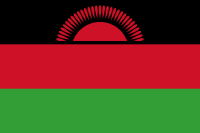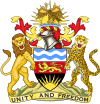Malawian Defence Force
| Military of Malawi | |
|---|---|
 Flag of Malawi | |
| Service branches | Army (includes Air Wing and Naval Detachment), Police (includes paramilitary Mobile Force Unit) |
| Leadership | |
| Commander-in-Chief | Joyce Banda |
| Personnel | |
| Military age | 18 |
| Reaching military age annually | (2002 est.) |
| Active personnel | 25,500 (ranked 140th) |
| Expenditure | |
| Budget | $9.5 million (FY00/01) |
| Percent of GDP | 0.76% (FY00/01) |
The Malawi Defence Force[1] is the state military organisation responsible for defending Malawi. They originated from British colonial units formed before independence in 1964.
Malawi army
The Malawi Rifles was a unit in the Malawi army formed on the country's gaining independence from the United Kingdom in 1964. Its first battalion was formed from the 1st Battalion, King's African Rifles. On independence the battalion became 1st Battalion, The Malawi Rifles (King's African Rifles). They were based (and elements still may be based) at Cobbe Barracks, Zomba. On 6 July 1966 Malawi became a Republic and His Excellency The Hon. Dr. H. Kamuzu Banda became the first President of the new Republic. After the swearing in Ceremony his first duty was to present the Battalion with his own Presidential Colour and the new Regimental Colour.[2] It was under the leadership of Brigadier Paul Lewis, a British expatriate.[3] In 1964, at Malawi's independence, the Malawian Army consisted of one battalion with 2,000 soldiers at Cobbe Barracks in Zomba.
The Malawi army is now made up of two rifle regiments and one parachute regiment. The military is organized under the purview of the Ministry of Defence. State Department IMET training documentation from FY 2003 indicates the United States trained army personnel from the 2nd Battalion, Malawi Rifles, 3rd Battalion, Malawi Rifles (Moyale Barracks), the Parachute Battalion, and the Combat Support Battalion (Mvera).[4]
In 1993, the army played a vital role in dismantling the dictatorship of Kamuzu Banda.[5] After Banda announced multi-party elections, the army intervened by dismantling Banda's paramilitary wing, the Malawi Young Pioneers in one night during an operation called "Bwezani" which means "taking back" or "returning". This event marked a vital point in the ideology of the Malawi army that was to follow. The Malawi Army therefore has had no political aspirations themselves, and have allowed the democratic process to occur in Malawi as guided by civilians.[5]
On April 5, 2012 when President Bingu wa Mutharika died, there were rumors of an attempted constitutional coup intended to prevent vice-president Joyce Banda from becoming President as outlined by the Constitution.[6] The military stepped in and vowed to support and uphold the constitution of Malawi. They reportedly stationed security members at Banda's residence during the news of Mutharika's death.[7] This level of professionalism had a direct impact on the smooth transition of power.[6]
Air Force
The Malawi Air Force was established with German help in 1976 with the delivery of six single engined Dornier Do 27's and eight Do 28 light twins in 1976-1980. Also in the same era the air force received an Alouette III, an AS 350 and an AS 355 Ecureuil, as well as three SA 330 H/L Puma Helicopters from France. A single BAE 125-800 was delivered in 1986. Four Dornier Do 228 light twin turbo props were acquired between 1986 and 1989 in part to dispose of the older Dornier products. In 1990 two Douglas C-47's and PT6A turboprops were delivered from the US.
Aircraft inventory
The Malawi Army Air Wing operates the following aircraft:[8]
| Manufacturer | Model | Type | Service entry | Number | Notes |
|---|---|---|---|---|---|
| Dornier | Dornier 228 | Tactical Transport | ? | 2? | Two confirmed in service 2006, possibly two more[8] |
| Hawker Siddeley | Hawker Siddeley HS-125 | VIP Transport | 1986 | 1 | Possibly replaced by Falcon 900EX in 2010 |
| Dassault Aviation | Falcon 900 | VIP Transport | 2010 | 1 | 900EX registered as 7Q-ONE in 03/2010 [9] |
| Eurocopter | SA 330 Puma | Multi-purpose helicopter | 1976–1980 | 2 | |
| Eurocopter | Eurocopter Dauphin | Multi-purpose helicopter | 1976–1980 | 1 | |
| Basler | Basler BT-67 | Cargo aircraft | 1990 | 2 | |
| Dornier | Dornier Do 228 | Light transport aircraft | 1986–1989 | 4 | |
| Eurocopter | Eurocopter AS 350 Ecureuil | Light utility helicopter | |||
| Eurocopter | Eurocopter AS355 Ecureuil 2 | Light utility helicopter | ? | 1 |
On 28 January, 2013, the office of President Joyce Banda announced that the Dassault Aviation Falcon 900 will be sold to the highest bidder, as part of cost-cutting measures.[10]
Retired Aircraft
- Aerospatiale Alouette III
- Aerospatiale AS 332 Super Puma
- Britten-Norman Defender
- Britten-Norman Islander
- Dornier Do 27
- Dornier Do 28
- Hunting Percival Pembroke
Malawi has a very small navy as it is landlocked. In 2008, it had 225 personnel.
- 2 patrol boats
- 1 Landing Craft Utility
Notes
- ^ www.sdnp.org.mw, 2011 budget document
- ^ http://www.memoriesofrhodesia.com/pages/audio/troopingcolour.html
- ^ http://malawi.freehosting.net/article3.html
- ^ http://www.state.gov/documents/organization/34329.pdf
- ^ a b REUBEN CHIRAMBO (University of Malawi, Malawi), “OPERATION BWEZANI”: THE ARMY, POLITICAL CHANGE, AND DR. BANDA’S HEGEMONY IN MALAWI, Nordic Journal of African Studies 13:2, 2004,
- ^ a b http://www.nyasatimes.com/malawi/2012/04/09/president-banda-has-her-work-cut-out/
- ^ http://articles.cnn.com/2012-04-06/africa/world_africa_malawi-president_1_malawians-president-bingu-wa-mutharika-patricia-kaliati?_s=PM:AFRICA
- ^ a b Malawian military aviation OrBat
- ^ Falcon Production List
- ^ BBC. "Malawi's Joyce Banda auctions presidential jet". BBC News. Retrieved 29 January 2013.
References
- World Aircraft Information Files. Brightstar Publishing, London. File 337 Sheet 02
- World Aircraft Information Files. Brightstar Publishing, London. File 340 Sheet 05
Further reading
- Tim Stapleton. "'Bad Boys': Infiltration and Sedition in the African Military Units of the Central African Federation (Malawi, Zambia and Zimbabwe) 1953-163." The Journal of Military History 73, no.4 (2009): 1167-1193.
External links

